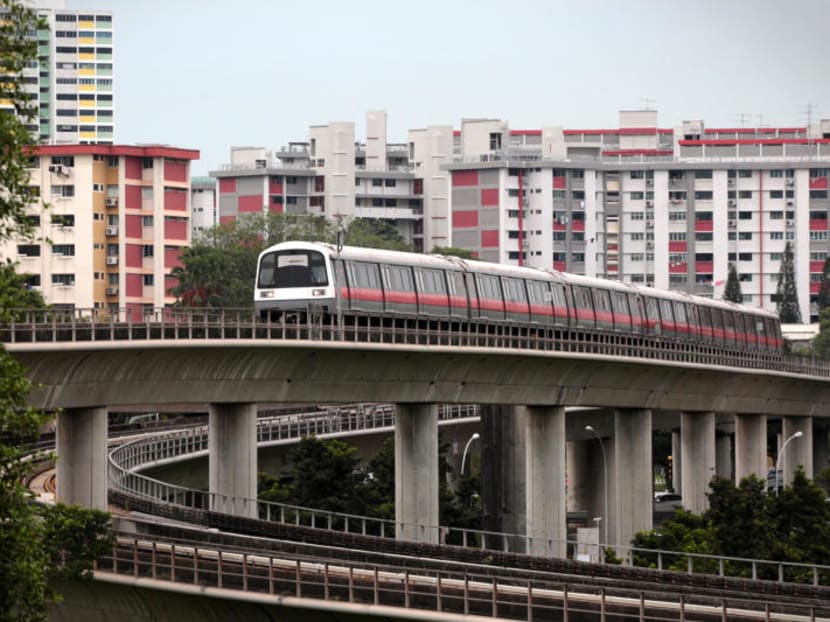MRT train reliability improved in Q1: LTA
SINGAPORE — Trains across the MRT network travelled further in the first quarter of this year before encountering short delays, with a more than two-fold improvement over last year’s performance.

In the first quarter of this year, trains across the MRT network travelled further before hitting short delays. TODAY file photo.
SINGAPORE — Trains across the MRT network travelled further in the first quarter of this year before encountering short delays, with a more than two-fold improvement over last year’s performance.
Releasing its rail report card on Wednesday, the Land Transport Authority (LTA) said trains across all lines travelled an average of 354,000 train-km before hitting delays of more than five minutes in the first quarter.
This is more than double the “mean kilometre between failure” (MKBF) — a measure of train reliability — of 174,000 train-km registered for the whole of last year.
The Downtown and North-East lines recorded the steepest improvements. The Downtown Line turned in an MKBF of 1,033,000 train-km, up from 260,000 train-km last year. The North-East Line clocked 973,000 train-km, markedly higher than last year’s 174,000 train-km.
Meanwhile, the North-South and Circle lines recorded an almost two-fold improvement: The North-South Line had an MKBF of 291,000 train-km, up from last year’s 156,000 train-km, while the Circle Line registered 452,000 train-km, an improvement over last year’s 228,000 train-km.
The East-West Line, which showed the smallest improvement, clocked 215,000 train-km, a 48 per cent improvement from last year’s 145,000 train-km.
There was one major delay of more than half an hour — on the East-West Line — in the first quarter, compared with an average of four per quarter across the MRT network last year.
On the Light Rail Transit (LRT) network, reliability also improved across both the Bukit Panjang and Sengkang-Punggol LRT lines. They recorded an MKBF of 65,000 car-km in the first quarter, a 33 per cent improvement from last year’s 49,000 car-km.
Major LRT delays stood at four in the first quarter, a touch lower than the average of 4.5 per quarter last year. The LTA attributed the improvements in MRT reliability to “steady progress” of major infrastructural renewal projects and investments by public transport operators in enhancing maintenance procedures and incident-recovery processes.
The Government has set an MKBF target of 300,000 train-km for the rail network this year. While the network’s performance has exceeded the target, LTA deputy chief executive (infrastructure and development) Chua Chong Kheng acknowledged that “this is only the first quarter”.
Asked if he expected reliability to fall in the second quarter since several incidents had already occurred, Mr Chua said: “This is over the whole course of the year … While you’ve one incident on the line, there are many good journeys that have been completed on other lines.
“And all these have helped to make up for the overall target.”
Offering an update on renewal efforts, he said work to replace the third rail, which supplies power to trains, on the North-South and East-West Lines (NSEWL) is more than 95 per cent completed and will wrap up over the next month or so.
The LTA, he added, also recently called two tenders to upgrade the NSEWL’s power system, which will include condition-monitoring tools to enhance service reliability, fault detection and identification capabilities.
The tenders are expected to be awarded by year’s end or early next year. Mr Chua said the LTA also expects to award the tender to replace 66 ageing first-generation NSEWL trains early next year.
Meanwhile, 11 trains are being added to the Circle Line to prepare for the 2025 opening of Circle Line Stage 6, while four have been added to the Downtown Line for the Downtown Line 3 extension’s opening in 2024.
As part of the push towards predictive maintenance, the authority will also call a tender for the Rail Enterprise Asset Management System, which will integrate and track asset information across all rail lines, and allow the LTA to analyse trends and predict faults.








